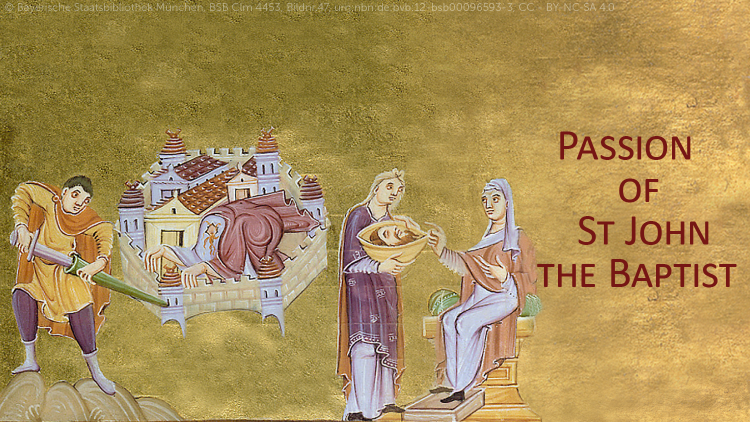
Memorial of the Passion of Saint John the Baptist
The king promptly dispatched an executioner with orders to bring back his head. He went off and beheaded him in the prison. He brought in the head on a platter and gave it to the girl. The girl in turn gave it to her mother. When his disciples heard about it, they came and took his body and laid it in a tomb. (MK 6:17-29)
The motivations for John the Baptist’s martyrdom
A woman played the primary role in his martyrdom. Herodias, the wife of Herod Antipas, was the former wife of his half-brother. John was arrested because he had denounced her illegal marriage. During the celebration of Herod’s birthday, Herodias’s daughter, Salome, performed a dance in honor of the king who remained enchanted and told her she could ask him for anything she wanted, even to half of his kingdom. After consulting her mother, Salome asked for the head of John the Baptist. Herod did not want to do it, but could not refuse: he had, after all, made a promise.
Pope Francis’s commentary
There are four characters: King Herod “corrupt and indecisive”; Herodias, the wife of the king’s brother who “knew only how to hate”; Salome, “the vain ballerina”, and the “prophet, decapitated and alone in his cell”.
The king
The king “believed John the Baptist was a prophet”. Initially, he protected John and “liked to listen” to him. But he kept him in prison. He was indecisive because John had accused him of the sin of adultery. Herod “heard God’s voice” in the prophet, “telling him to ‘change your life’. But he did not succeed in doing that. The king was corrupt. It is difficult to get out of corruption”. His corruption led him to attempt to strike a “diplomatic balance” between his own life, which was not only adulterous, but also “filled with many injustices that he kept going ahead with”. He was also aware of the “holiness of the prophet that was before him”. But he did not succeed in untying the knot.
Herodias
The second character is Herodias, the wife of the king’s brother who was put to death by Herod in order to have her. The Gospel says she “hated” John” because he spoke with clarity. “We know that hatred is capable of anything”, Pope Francis commented. Indeed, “hatred is a great power. Hatred is the breath of Satan. Think about it: he does not know how to love, he cannot love. His ‘love’ is ‘hatred’. And this woman possessed the satanic spirit of hatred” that destroys.
Salome
Finally, the third character, the daughter of Herodias, Salome, the wonderful dancer, “who so pleased the guests and the king”. In his enthusiasm, Herod promised the girl, “I will give you everything”. “He uses the same words that satan used to tempt Jesus. ‘If you adore me, all this is yours’.” But Herod could not have known.
John the Baptist, a holy man
“Satan is behind all these characters. He sows hatred in the woman, vanity in the young woman and corruption in the king”, the Pope concluded. John, “the greatest man born of a woman died alone in a cell because of the whim of a vain dancer, the hatred of a diabolical woman and the corruption of an indecisive king. The Baptist dies a martyr. Not a martyr of the faith, because he was not asked to renounce it. He is a martyr of truth. He was, in fact, a “righteous and holy man” (Mk 6:20) who was put to death because he spoke freely and was faithful to his calling. He is a martyr who allowed himself to diminish so as to leave his place to the Messiah. “Those who are great end up like this!”. But John knew he had to be annihilated: “He must increase, I, instead, decrease”. And, added Pope Francis, “he decreased to the point of death”. John had pointed Jesus out to His first disciples, indicating that He was the Light of the world. He, instead, gave his life little by little, to the point of being extinguished in the darkness of a prison cell.
“Life has value only when we give it; when it is given in love, in truth; when we give it to others, in daily life, in our families. It should always be given. If someone grasps his or her life in order to keep it, like the king by his corruption, or the woman with her hatred, or the child, the young girl with her vanity that was that of an adolescent, naive, life dies, life ends up withered, it is useless” (Homily of Pope Francis, Santa Marta, 8 February 2019).








